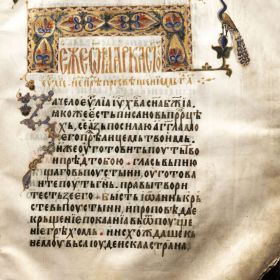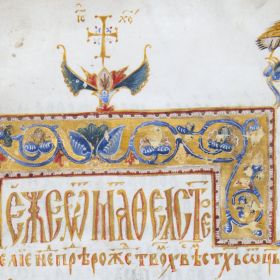The Tetraevanghelion of Pious Nicodim from Tismana
Scribe: Nicodim from Tismana
Texts: Dr. Ginel LAZĂR / Photo: Marius AMARIE
One of the oldest manuscripts in Wallachia, with the oldest adornment, it’s exhibited in the National Museum of Romanian History, and was transcribed by the Pious Nicodim, the abbot from Tismana Monastery.
During his last years of life, between 1399 and 1405 Nicodim lived in the Prislop Monastery, where between 1404 and 1405, he handwrote and decorated with miniatures the Four Gospels, to which he attached masterly crafted silver plated covers. This work is now considered to be a piece of art of its epoch. The dating appears on the back of the last page, with the following text: „This Holly Gospel was written by the priest Nicodim in Terra Hungarorum in the sixth year of this chase for Hesychasm. Counting since the Creation of the World the year 6913 (1405)”.
The manuscript it’s an astonishing piece of art, with many ornaments (frontispieces, colored capitals and golden letters and titles) and the wooden barks are locked in gilded silver plates. The first one depicts „the Crucifixion of Jesus”, being illustrated the Saints Mary and John and above the inscription „King of Glory”, and the last one „The resurrection of Lord, depicted according to the Byzantine tradition (Anastasias), remarkable for the harmonization of silhouettes, the special care for building architecure, the careful outlining of the shapes and the expressive motion. The Four Gospels includes 322 files. The scribe’s name and of the miniaturist who created it, the pious Nicodim, it is written on the second-last back-page (316), in a holograph belonging to Anton Pann (from 1844) that mentions: „this Saint Gospel was written by the priest Nicodim from Terra Hungarorum in the sixth year of his banish and since the Beginnings of Being, counted (years) 6000 and nine hundreds and 13.” Each Gospel begins with a frontispiece decorated with geometrical motifs and birds (peacocks), the capital letter decorated with miniatures with decorative motifs, all in colored inks. At the end of each Gospel was written a summary of pericopes. On the last tab of the manuscript could be found two texts, one written in ink, and the other one in pencil, from 1811, respectively 1882, referring to those who read the piece of work and to the age of the manuscript.
The pious Nicodim of Tismana
Born in Prilep, of Serbian mother and Greek father, Nicodim, since he was an infant felt a truly attraction towards the monastic life. Mount Athos represents a true calling and challenge for Nicodim, where he eventually finds his soul peace and simultaneously develops and improves his highest ecclesiastical knowledge. In this centre of Oriental monasticism he apprenticed in workshops where representative orthodox literary pieces of work where transcript, rep-resenting an opportunity for him to learn the cultural languages of the Eastern Christianity, namely Greek and Slavic. He also remarks himself as a calligraphist and miniaturist.
Nicodim the monk and the friars who came from southern Danube, from the medieval Serbia, are the founders of the first monasteries in Wallachia organized by the model of those from their native communities. These were built during Vladislav Vodă and Radu I reigns. The first of all that were to be erected was Vodița, buit on Danube shore, in the vicinity of Turnu Severin. The Wallachian prince, Vladislav Vodă, grants to the monks privileges and significant annual revenues from the royal treasury, and the exclusive right to fish in the ponds of Danube, according to the earliest local Slavic document of the Royal Office. After the establishment of Voivodița, as a monastic settlement, Nicodim searches for quieter and more secluded place to establish another monastic center by the model of the one from Mount Athos. This place was found in the mountains of Gorj, where he erects Tismana Monastery. Besides building the monastery he focuses as well on shaping the monastic life, according to the customs learned at Mount Athos. Tismana Monastery was ranked as Archimandry, being actually the first major Archimandry in the country (The big Lavra), where Nicodim was already entitled as archimandrite. Subsequently was built Vișina Monastery on Jiu Valley. Some of his apprentices moved to Transylvania in Hațeg Lands where they establish the Prislop monastery.
At the end of his life he would retire at Prislop monastery as a result of an eventual dispute with Mircea the Elder.
Nicodim dies at an advanced age, on December 26th 1406, during the reign of Mircea the Elder, being buried in the porch of Tismana monastery. Later, his relics were sent back to Serbia, his birth country. For all his contributions to Orthodoxy and Romanian people he was considered the spiritual patron of Oltenia.
The Orthodox Church celebrates him on December 26th, the day when the Saint passed away.
The role of the Church in spreading the art of miniature
Until the movable type printing was invented, first in China and Korean Kingdoms, subsequently in Europe, in the second part of the 15th century, the most common means of recording, keeping track and preservation of the human kind reflections and erudition were the manuscripts.
In compiling a history of mentalities, the transcription of religious manuscripts, development of miniature art, the decoration of evangelical books and the movement of such masterpieces play a key role, considering that the dissemination of the works transcribed after Byzantine and Balkan Slavic models could represent a source of information regarding certain historical, social and economical context, as well as of the expansion and interference of religious, cultural and ideological ideas or regarding the spiritual atmosphere of that time.
The invention of the mechanical printing in Germany in the mid 15th century played a key role not only in development the Western Christianity, but in the life of Eastern Church as well. Today we barely could imagine the importance of this event in a period when the knowledge was perpetuated for centuries by copying the manuscripts in the monasteries. The scarcity of books made them an object of high value, craved by scholars, boyars/nobles and Kings/Princes. Throughout the Middle Ages, both in the West and in the East, written culture was transmitted through the labor of scribe monks who in addition have transformed calligraphy and miniature painting in a veritable art, making the book a masterpiece, decorated with illustrations on golden background, with heavily adorned frontispieces, with uppercase letters knitted with floral motifs, beautifully covered in leather or locked in gilded silver.
In the Danube Romanian countries, the Slavic language holds the privilege in the cultural life, being the liturgical and the Royal Office language.
The Latin it’s being used mainly in Transylvania, in the ecclesiastical centers and in Prince Office. The main centre of culture during Romanian Middle Ages was the institution of Church, where the arts of calligraphy and miniature develops by copying some of the most remarkable manuscripts, used for endowing the settlements of worship. Simultaneously the emergence of the mechanical printing allowed the spread of Christian Teaching through the means of printed books of worship.




















